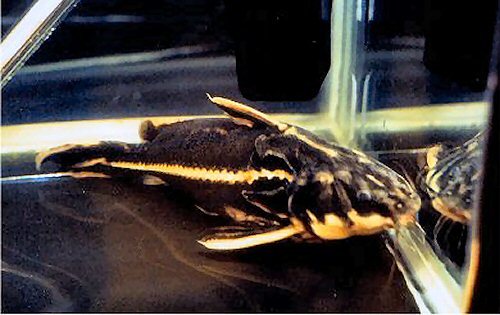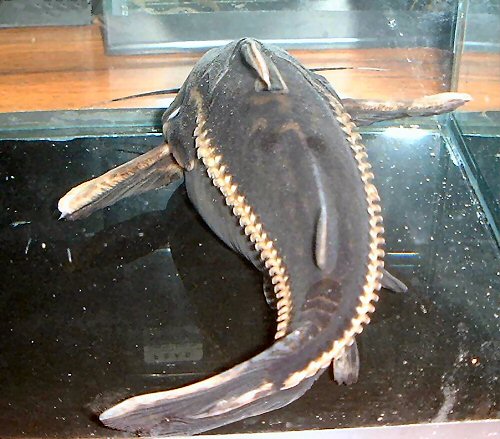Orinocodoras eigenmanni (Myers, 1927) |
| Synonyms: |
| None |
| Common Name: |
| Long-nosed Raphael Catfish |
| Family: |
| Doradidae |
| Subfamily: |
| Doradinae |
| Distribution: |
| South America: Orinoco River basin: Venezuela |
| Size: |
| 17.5cm (7ins) |
| Temp: |
| 23-26ºC (73-79ºF) |
| pH.: |
| 6.0 - 7.0 |
he common name for this Dorad catfish is the “Long-nosed Raphael Catfish” to differentiate it from the similar looking “Raphael Catfish” Platydoras costatus. The genus Orinocodoras is Monotypic (containing only one species). In the U.K. the common name for costatus is usually “Humbug” or “Chocolate Talking Catfish” pertaining to them being able to create a sound by grating their fin bones in each socket and amplifying the noise via the swim bladder, this also applies toO.eigenmanni.
 |
This fish is probably imported alongside P. costatus, for if you look into a tank of the latter in any shop you will usually find one or two eigenmanni there. They are quite easy to spot with experience, aseigenmanni, as the common name suggests, has a longer nose, plus the scutes that adorn the sides of the body are smaller, and I find that it is usually a bit darker in colouration than costatus.This is a very nocturnal catfish, so give it plenty of hiding places such as pipes or rockwork and you will get the added bonus of seeing it on the odd occasion.
As can be seen in the photograph this can be a very impressive looking catfish when adult and in common with costatus it can get quite heavy in the body.
 Orinocodoras eigenmanni - showing scutes |
The picture above shows the impressive scutes that adorn both sides of its body
| Characteristics |
Dorsal Spine; Serrated on both anterior and posterior edges.
Fontanel; Continued as a groove to the base of the dorsal fin.
Adipose; Continued forward very slightly into a keel.
Caudal Peduncle; Covered with caudal fulcra above and below.
| Colour |
| Compatibility |
| Breeding |
| Feeding |
| Etymology |
| Orinocodoras: From the Orinoco River; doras = cuirass ( helmeted) eigenmanni : In honour of Dr.Carl H.Eigenmann, Professor of Ichthyology in Indiana. ( 1863-1927.) |
| Glossary of Terms |
| Fontanel - The space(s) between the bones on top of the skull covered by skin. Caudal Peduncle - The area between the dorsal fin and the tail. |
| References |
![[uNGu]™](https://blogger.googleusercontent.com/img/b/R29vZ2xl/AVvXsEgrPnhQswWH1n3co_BH9h53yVB4bM90uN-8zYlArwsG5kGjTCPGH7df0Y3uZofyDG2x9zRWH_wjTJ8NDmxsO-H3eYm9EXels8TVpJLKCth08DpTMXgxDvj_5BJCNRK0xall6aKLawXkQEER/s1600-r/Ungu_long.JPG)














0 comments:
Posting Komentar